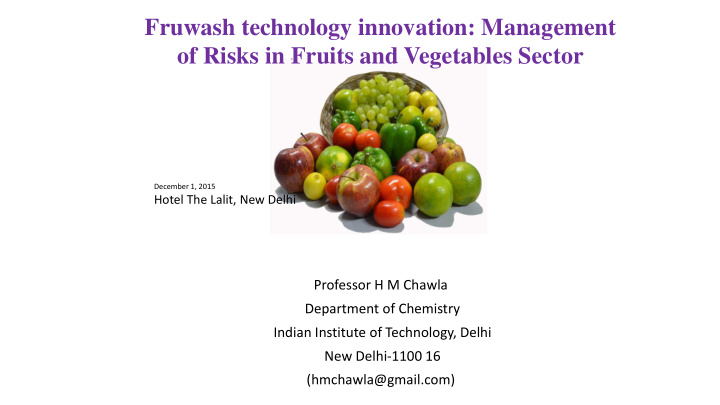



Fruwash technology innovation: Management of Risks in Fruits and Vegetables Sector December 1, 2015 Hotel The Lalit, New Delhi Professor H M Chawla Department of Chemistry Indian Institute of Technology, Delhi New Delhi-1100 16 (hmchawla@gmail.com)
Management of Risks in Fruit and Vegetable Sector Several risks in F&V sector- • Production(Raw materials, processing, fertilizers, irrigation, etc) • Harvesting(impediments and expedients) • Post harvest treatments(preservatives, chemicals, CA/MA deployment, cold chain, cold storage, refrigerated vans etc) • Uncertainity in Post harvest supply chain (regional and seasonal nature) • Difficulties in Sales, Marketing, financial networks/mechanisms
Risks can be reduced significantly • Own the problem. Shed compartmentalization. • Innovate management through Science and Technology. • KITBAPS ( Knowledge-Interaction-Technology-Business- Apportionment-Profits) • Quality, quantity, standards and safety- Essential for achieving global competitiveness and to target domestic and export markets
INDIA : Fruits and Vegetables, a case of Poverty in plenty and considerable risks at all levels • India ranks first in varieties and second in extent of F&V production in the world with 76.42 and 156.3 million metric tonnes of fruits and vegetables produced,. ( NHB, 2012 ). Still our children remain under or mal nourished • Area under cultivation for fruits is 6.70 and 8.88 million hectares for fruits and vegetables resepectively. • F&V exports are low (Rs.5986.72 Cr; fruits; Rs. 2503.75 Cr and vegetables; Rs. 3482.97 Cr) due to quality and safety parameter mismatch • S&T measures to increase more production is helpful but beyond certain level, it is counter productive in many ways • Food Processing units, though increasing are still very low(3% vs 75-80% in Malaysia) Dichotomic nature of Indians do not mitigate ergional and seasonal risks. • We Produce huge quantities, waste maximum, and ironically contribute about 96 million tonnes of difficultly treatable solids)
40-45% never reach the consumer (96 million metric tonnes of wastes) Direct losses of 45000 cr (TIFAC) Freshness undefined Fruits and 13,500 (Emerson) Fresh(?) fetch price Vegetables 100000 (Dubai Airport) Stale low or no price Region and season specificity In both, Glut and scarcity, Small former / vendor suffers
Post Harvest Losses Share in Production Graphical description of Loss (% of 257.2 million MT) Metric Tonnes Contribute to ~96 MMT solid wastes
Risks in F&V Segment-few standards with scientific scrutiny • F&V Freshness is a complex subject (often adjudged empirically through signs of staleness). • Level of Oxidation • Physiological weight loss • Color (anthocyanins and other natural pigments etc) • Juice content and TSS • Texture • Loss of firmness • Microbiological parameters, enzymes and their activity in vivo and in vitro • Production and degradation of sugars during post harvest time • Sensory parameters like aroma and other attributes specific to fruit
Fruwash: First Technology development resulting from • Collaboration of researchers from different institutes IITD, IITB, IITRI, Gujarat University, PAU, Ludhiana, GNDU, Gorakhpur, SRI, SKU(Srinagar), Indian Institute of Gums and Resins • Contribution form different funding agencies DST, DBT, IITD, MoFPI, MoRD, MoEF, Planning commission, CSIR, NRDC • Involvement of different subjects Chemistry, natural products, chemical engineering, Mechanical engineering, Management, Rural Development, Food Processing, Biotechnology, Environmental Sciences, Agriculture, IPR etc • Winner of several awards CSIR(NEERI)-Burhani Foundation, Lockheed Martin Gold medal, NRDC invention award, MN Desai, SPARCs Awards, BBC-World News(Horizon Program), Indian channels, media etc
Fruwash • Fruwash is an organic natural product based biodegradable formulation • Extends natural shelf life of fruits and vegetables at high ambient temperatures without refrigeration • Non toxic, edible, treated fruits can be consumed without washing • All fruit characteristics remain extremely close to freshly harvested horticulture produce(TSS, Juice, PWL, crispiness, chewiness, crunchiness, flavour)
Reduces wastage significantly Without refrigeration Less power consumption Economic empowerment Provides time for optimized of women, handicapped, Fruwash use of food processing street vendors, small Technology machinery farmers Innovative jobs in rural areas, triggers creation of new products at Regional / National level
Statutory Approvals and patents (AVA, FSSAI, SA, TM processing aid) Lacifera Lacca Indigenous RM / Pilot Fruwash Well proven (16 states) Process/basic engg. Technology validated Cost effective
Design of pilot Plant
Pilot Plant at IITD
FRUIT BASKET • The entire coating process takes 3-4 min and fruit is ready for dispatch • Each coating has the potential to employ 5 BPL persons • To sustain jobs through the year, apples, tomatoes, pears are taken COLD WATER CIRCULATION PIPES
Cost of Fruwash The cost of FruWash is very cheaper in comparison to Cold storage or other fruits and vegetable preservation methods. For Preserving 1 Quintal of Apple for 2 months in a cold storage, it costs around Rs 440 + Transportation Cost for bringing F&V from Field to the Cold Storage., power requirements and initial capital costs For fruwashing it will cost around Rs 200/- . (@ Rs2/- per KG )No transportation cost will be required. Just See the difference … .. FruWash Availability in the packing of 500ml, 1, 5 &10 Ltrs
Recommend
More recommend